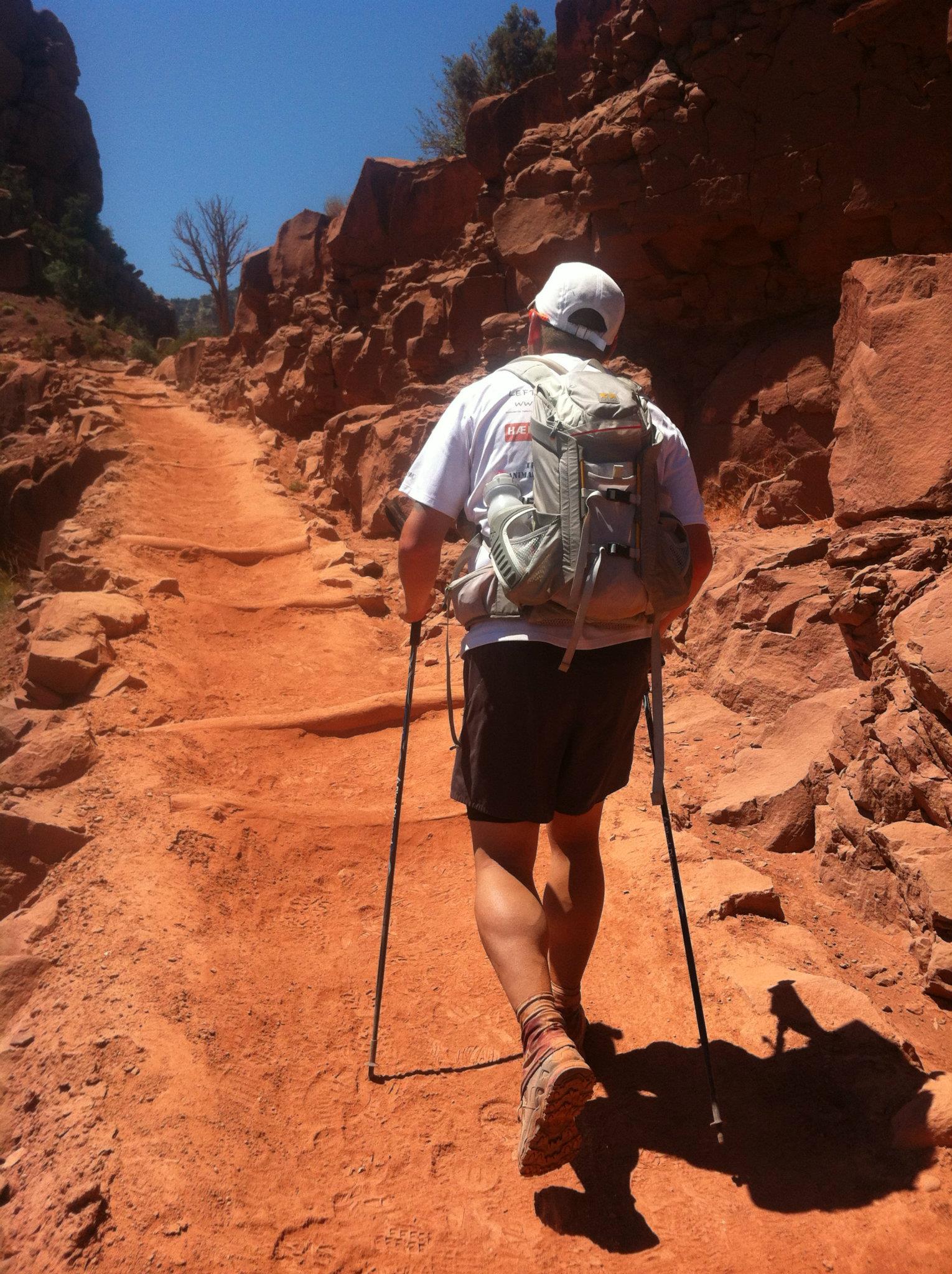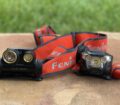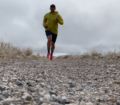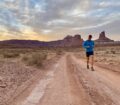To pole or not to pole… this seems to be the great debate within the ultra world as of late. Following our other Trail And Ultra Running article, I’ll continue the coverage with another perspective. Ultimately, we’re all trying to take a stab at answering the question without putting too sharp of a point on it.
I used to be a purist. I thought trekking poles were for old people or wimps. I’m not old, and I’m certainly not admitting to being a wimp (although it might be true). Trekking poles were an unnecessary bother, just another piece of equipment to complicate what should be a simple existence on the trail. Case in point: while walk-running through the last 5 miles of the BigHorn 100 last year, a lovely 50-miler who was patiently hanging in with me for those last miles offered to let me borrow her trekking poles. I must have seemed bad off. I tried them out for a few minutes, but at that point my brain just couldn’t handle anything new. They seemed complicated and cumbersome…and definitely not necessary on the flat road. At the time, they didn’t make sense to me. So, I put them out of my mind…. until I got a pair for Christmas and decided to open my mind back up to the option of trekking poles as a potentially useful tool of the trail.
I used them one time on a 20 mile hill run before my next 100 mile race. They were okay, but they bugged me a little on the downhill section of the run. I was still not convinced. The next time I used them was at the Salt Flats 100, a race with mild terrain and not so much elevation change. I picked them up at mile 22 and never looked back, choosing to hold onto them even through the last 5 or 6 miles of pavement, when I was sure the clicking of the metal on the road would drive my pacer to put me out of my misery with one of them.
Since that race, I have turned my focus toward hill running and have done all of my long training runs with the poles. They have continued to grow on me, and I have figured out what I perceive to be the positives and negatives about them. For me, the positives now outweigh the negatives and I will continue to use them in long runs and races.
The “Advantage” Debate
Whether or not trekking poles actually are an advantage is entirely a matter of personal opinion. Some feel they offer a distinct advantage; others feel they are an annoying hinderance at best and a hazard at worst. Is any perceived advantage unfair? No because in races either everyone is allowed to use them or everyone is banned from using them. Either way, the playing field is level AND the true is that most people using the poles are not the ones vying for the podium.
My opinion is that poles offer an advantage for some people and on some terrain. If the only factor being considered an advantage is speed, then no, I do not think they are advantageous. Trekking poles do not make you faster. But the other possible advantages are real for some people. I prefer to approach this discussion in terms of pros and cons and then leave the decisions up to you:
PROS
Elimination of Hand Swelling
Use of trekking poles can dramatically reduce or even eliminate swelling in your hands. My evidence on this point is anecdotal, but two of my friends who experience SIGNIFICANT hand swelling noticed greatly reduced swelling when using the poles over both long and short runs, when they would normally have had debilitating hand swelling (as in, they could not use their hands to do things like tie their shoes). In these cases, the hand swelling seems to be more a function of pooling in the hands than of elevation or electrolyte imbalance. The combination of raising the hands to chest level and the clenching action on the hand grips cannot be ignored as something that is helpful to some in during an ultra marathon.
Sleeping, Stretching, and Scratching
Trekking poles can be a great leaning post for resting or maybe even catching a few ZZZs in the middle of the night. Brace yourself on them to stretch out the backs of your legs, or even use them to roll out your leg muscles – one of my favorite non-forward-motion purposes for poles. I have also found that they come in very useful for scratching bites on the lower legs without having to bend down.
Water Crossing Stability
Poles can help you make creek crossings without getting your feet wet…or simply help you make water crossings without flat-out falling in. A friend who did Hardrock last year says they were invaluable over the numerous high water crossings. Make sure you get a good plant with the poles on slick, rocky river bottoms, however, or the results could be disastrous.
Downhill Stability
I have arrested several near-falls with my trekking poles on descents, although it does take practice to get good at planting the poles appropriately while maintaining your speed going downhill. This is an area where I think more adept downhillers than myself would find trekking poles to be a hinderance. If you’re more cautious, like me, the poles can being an advantage. If you like to fly like a bat out of hell downhill on technical terrain, then poles will probably slow you down.
Relieve Stress on Knees and Quads Going Down
A local runner acquaintance of mine says he uses poles almost like crutches on the steep descents, and he feels they relieve stress on his knees and quads on the downhills. I had a painful IT band flareup the other day that made downhill running a trying experience, and using the poles to lower myself down some really steep grades was absolutely a relief to my knee.
Balance
A friend of mine who has vertigo says that the poles help her feel more comfortable on narrow trails bordered by drop offs. Even if you don’t have vertigo, poles can assist you in maintaining balance on tough trails, especially technical descents.
Rhythm
Trekking poles are helpful in establishing and maintaining a cadence for forward motion. When you lock into a rhythm with your steps and the pole strike, the miles can pass more quickly, even if it’s just a mental benefit.
Relieve Stress on Your Legs
It is my experience that trekking poles help distribute some of my weight to my arms and shoulders… taking a little weight off my legs. After using the poles for 70 miles of my recent race, I thought my arms and shoulders would be fatigued or sore, but this was not the case at all. I did feel as if I was burning more calories and needed to eat more than I was accustomed to, but I feel the increased calorie burn is worth the reduced fatigue to the climbing muscles. A friend of mine says she found poles to be invaluable crossing what seemed like hundreds of stone and log water bars through the Grand Canyon. Using the poles for leverage on ascents feels like a benefit, whether slow or fast hiking.
Use as Weaponry
Use as a weapon as needed. My friend A.K. has it all worked out how she would impale a wild horse in the nostril if attacked. Look. We’re not out arbitrarily hunting down horses, but we were stalked one time by wild horses doing their best impression of the Native Americans in The Outlaw Josie Wales, so it’s always good to be prepared. Also under the weaponry category would be using poles to stab your pacer in the rear if they happen to irritate you; and you know they will. You could definitely make a valiant attempt at fending off a dog or wild animal with your poles, but make sure you don’t stab something by the side of the trail that you wouldn’t have otherwise disturbed without the extra breadth of the poles.
[Continued Below]
[tabs slidertype=”images” auto=”yes” autospeed=”4000″][imagetab width=”558″ height=”372″]http://trailandultrarunning.com/wp-content/uploads/2012/06/emily-berriochoa-trekking-poles-leaving-aid-station-eating.jpg[/imagetab][imagetab width=”558″ height=”372″]http://trailandultrarunning.com/wp-content/uploads/2012/06/trekking-poles-balanced-while-running.jpg[/imagetab][imagetab width=”558″ height=”372″]http://trailandultrarunning.com/wp-content/uploads/2012/06/emily-berriochoa-trekking-poles-ultra-ninja.jpg[/imagetab][imagetab width=”558″ height=”372″]http://trailandultrarunning.com/wp-content/uploads/2012/06/emily-berriochoa-trekking-poles-amy-king-still-friends.jpg[/imagetab][/tabs]
CONS
Hands NOT Free
For long races where packing water is a necessity, trekking poles require the use of a waist or back pack. I think using a hose on a pack may be a little easier than pulling bottles off a waist pack to take a drink, but either is definitely possible. You may need to make a more conscious effort at remembering to take drinks with the poles in your hands.
Also, if you are in the habit of carrying food out of aid stations and eating for a few minutes on the walk or run, simply tuck the poles under your arm and walk and eat as normal. Additionally, it’s easy to grip a baggie of food in your hand along with the pole handle. You can do most anything with poles tucked under your arm. On a recent run, I took off my pack, removed my rain jacket from the pack, put on the rain jacket, and put the pack back on, all with the poles tucked under one arm. If you need another ‘pocket’ to carry some food or stow gloves or whatever, you could also rig up a carrying pouch on your pole with duct tape and a baggie or small draw string cinch bag.
When running on flat or non-technical downhills, you may not want to use the poles. Most poles are very light (mine weigh ~8 ounces each) and will balance very nicely, one in each hand, barely noticeable while you tool along at a run.
One of my friends has rigged up a method for quickly attaching his poles to his pack with Velcro. This solution is great if there are long stretches in a race where you won’t want to use the poles, bracketed by sections you will definitely use them. It’s also a way around leaving your poles in a drop bag (for the amount of money I paid, I do not consider them disposable).
Cumbersome on Narrow, Brushy Trails
Trekking poles can be a pain on narrow trails bordered by brush or grass. They catch on foliage and trip you up if you’re not careful. You need a little extra width on the trails to accommodate the poles. One option is to simply pick up the poles and carry them through narrow brushy trail sections. You can also practice planting the poles in front of you rather than swinging them wide, but here you really have to be careful to not trip yourself.
More Equipment = More Stuff to Deal With
Carrying trekking poles obviously means you have to deal with another piece of equipment; and when your equipment breaks, it can leave you feeling abandoned, deflated, and disadvantaged. The key here is to not become so dependent on your trekking poles as to not be able to finish your race or run without them. I have heard a few stories of people breaking their trekking poles in various scenarios. My dad snapped a pair of expensive carbon poles right below the handles when he fell on them over a slippery creek crossing while wearing a heavy pack. His poles were more appropriate for ultra light hiking or trail running rather than heavy backpacking, but the moral of that story is that equipment is fallible, and you cannot depend on it 100%. Be mentally prepared to move on without if necessary.
In Conclusion
So where do I come down on poles? Are they an advantage? My anecdotal evidence really doesn’t point to a clear answer when talking about ultras. Does the energy saved on the legs, which might make you run faster longer, equal the amount of time spent dealing with increased complexity of extra equipment and counteract the increased calorie burn from using more of your upper body?
The debate continues. The only solution is a nice NIH funded study to get to the bottom of this.




















Very well written. Entertaining. Mildly astonishing that anyone could find 2000 good words to say about trekking poles. And make it interesting. Go you!
Thanks, Michael. 🙂
Wow! What a great article on trekking poles! I think I need to give them a shot.
A wonderful a detailed article-THANKS! I have been considering poles for months and this was very good information. Plus the photos are great!
“I have arrested several near falls…” Love the wording.
Thanks for the research and the article. I’m pondering mixing in a set of trekking poles into my trail running training (they seemed like a REAL good idea on that elevator shaft of an uphill stretch yesterday afternoon).
Very good comment.
Trail or mountain runner in europe , especially around the alpes adopted the poles running for decades now, even centuries if we speak walking. so i’m not sure that we should have a debate about it ! Those mountain peoples are not stupid, we should learn from our ancestors, elders or neighbors! Why running with poles would be good there and not in USA?
after this saturday mud ( i have never run much in the mud ) i have found other places to run when it is muddy in the boise front. it got me thinking about the use of poles and weather they would have helped me out. i am one of the old guys who does not climb worth a hoot. i think poles would have helped me out both climbing on the frozen ground and to descend in the mud. in my past i spent many years alpine ski racing and you would not think about not using poles, so i think they would come somewhat natural to me to use them. bottom line, i am up for a test….next time you may see me with poles. emily, great article, and great wilson creek this year. thanks again for all your effort, time and work.
This year the Bear 100 was a mudfest as well. Several runners (including the one I was pacing) ended up using poles and it ended up really helping them out in those later, muddy miles!